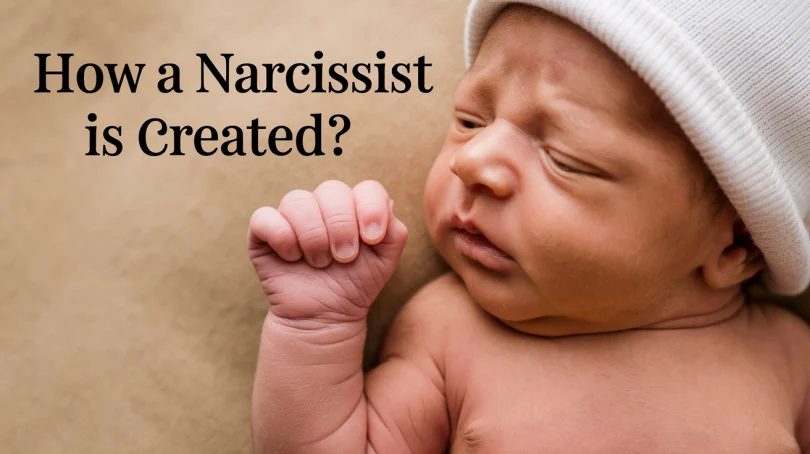Today’s topic is going to cover something I usually talk more about with professional audiences: How does narcissism develop? In essence, how do people become narcissistic? The Big Question: How Do People Become Narcissistic? This is a question that comes up a lot. Where does this pattern, which hurts so many people, come from?
I’ll be honest: I’m answering this question and making this article reluctantly. Here’s why:
It’s not because I don’t want to share the information. I’m a big believer that knowledge should be shared. However, sometimes, once people hear where narcissism comes from, they feel compelled to justify the narcissist’s behavior.
They might say things like, “Now that I know why they are the way they are, I kind of feel bad for them, and I don’t want to pull away from them.” Great, now you’re signing up to put up with more emotional abuse and remain even more stuck.
I can only ask you to hear this as a framework based on theory to help you understand these patterns. And please, don’t use this as a justification for someone’s mistreatment of you or for enduring more abuse.
You’re adults. You can take this information and recognize that while you can learn about where these patterns come from, you can’t change them.
Related Topics:
When The Narcissist Gets To Boss You Around
Unveiling the Enigma: Understanding Covert Narcissists
Narcissism and Developmental Issues
Narcissistic personality styles largely reflect developmental issues that develop through childhood. The narcissistic personality that emerges in adulthood largely reflects what happened to the person as they grew up, from childhood into adolescence.
Our personalities start developing from the day we are born, pretty steadily, until our early to mid-20s. During these years, our brains go through a rapid phase of development. By our mid-20s, things slow down, and our personalities get pretty well set like a Jell-O mold that stops shaking.
The Difficult Explanation: Adverse Childhood Experiences
Narcissistic personality styles are suggested to be a manifestation of what happens to a personality after being exposed to adverse childhood experiences. This could include neglect, abuse, inconsistency, and more.
Some of the patterns we see in narcissism are consistent with patterns observed in post-traumatic presentations. For example, after trauma, people may experience:
- Restricted expression of emotion
- A chronic perception of threat
- Impulsivity
Narcissism can also reflect a disruption in attachment. Secure attachment is the gold standard, created by early relationships with consistent and available caregivers who give the child a sense of safety and love and foster important skills like self-regulation.
Narcissism, however, is associated with anxious and avoidant attachment styles, where the person never feels safe in close relationships. There’s always a push-and-pull dynamic and a relative incapacity for deep and sustained closeness and intimacy.
The Role of Temperament
Temperament is the biological part of personality and is believed to be inherited. It explains why some infants are more difficult to soothe while others are easygoing.
A child with a difficult temperament may have a harder time in life. Parents, teachers, and adults may find them more challenging, leading to a more invalidating experience with the world. On the other hand, kids with easy, resilient temperaments tend to have an easier go of it.
Temperament, combined with adverse childhood experiences or disengaged parents, can raise the vulnerability for a narcissistic personality style.
Over- and Under-Indulgence
Some people suggest that narcissism develops from simultaneous over- and under-indulgence of a child. These children may be spoiled materially but emotionally neglected.
They’re given things like trips to theme parks, but their emotional worlds remain impoverished. It’s like being fed junk food; you’re not hungry, but you’re not nourished.
These children aren’t taught how to be comfortable with their emotions or how to self-regulate. Instead, they may be shamed for having emotions.
Modeling Narcissistic Behavior
A not insignificant proportion of narcissists may have had narcissistic parents themselves. Elements of narcissism like entitlement, rage, arrogance, and superficiality can be learned through modeling.
Children repeat what they see. If they see a parent yelling at a soccer coach or a store clerk, it becomes normalized. Narcissistic parents also have poor boundaries and may inject their emotions and needs into their child.
For example, if a child says, “Mommy, I’m sad,” a narcissistic parent might respond, “Oh, you just made Mommy sad.” The child learns that their emotions are a problem and may start avoiding sharing them.
Conditional Love and Validation Seeking
Many children are subjected to conditional love, being told, “I love you if…” or “I love you when…”
This can lead to narcissistic tendencies as the child grows up, seeking validation externally rather than internally. They may only feel loved when they achieve something, like winning a trophy or excelling in school.
Helicopter Parenting and Overprotection
In the era of helicopter parenting and bubble-wrap parenting, overprotecting children from disappointment can also lead to narcissistic tendencies.
Childhood is when we’re supposed to learn from disappointments, lost soccer games, bad grades, or not being invited to a birthday party. When parents shield their children from these experiences, they don’t learn how to regulate disappointment.
As adults, narcissists often don’t handle disappointment well and may throw tantrums when they don’t get their way.
The Role of Social Media
The extrinsic focus of how we raise kids, phones, gadgets, vacations, and social media can also contribute to narcissism.
Social media, in particular, can exacerbate narcissistic tendencies. When children are raised to value external achievements and validation (like followers on TikTok), they may grow up believing their worth is tied to these external factors rather than who they are as human beings.
The Bedrock of Narcissism: Insecurity
Everything I’ve described trauma, insecure attachments, conditional love, parental inconsistency, and unavailability can foster the bedrock of narcissism: insecurity.
When insecurity proliferates unchecked into adulthood and the person develops grandiose defenses (like entitlement) to protect that core insecurity, we see the evolution into narcissism.
Enabling Narcissism
Another way narcissism is maintained is through enabling. When enablers don’t call out narcissistic behavior, whether in children or adults, it allows these patterns to continue unchecked.
What We Don’t Know
We don’t have long-term longitudinal studies that follow children from infancy into adulthood to understand what factors prospectively lead to narcissism. Most of what we know comes from case studies and retrospective research, where adults tell us about their childhoods.
Final Thoughts
As an adult, you cannot undo another adult narcissist’s history. Unless the narcissist recognizes that something is wrong and seeks change, you won’t be able to fix them.
Understanding these patterns can foster empathy and compassion, but don’t use this understanding to rationalize enduring more abuse.
Conclusion
Narcissism has deep, complex roots. While understanding these patterns can be helpful, it’s important to set boundaries and prioritize your well-being.






